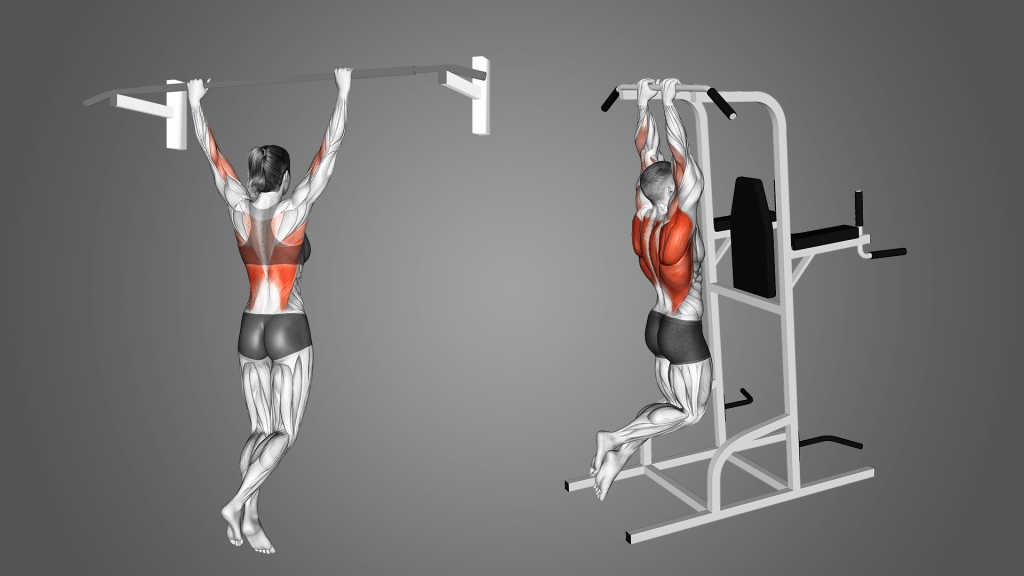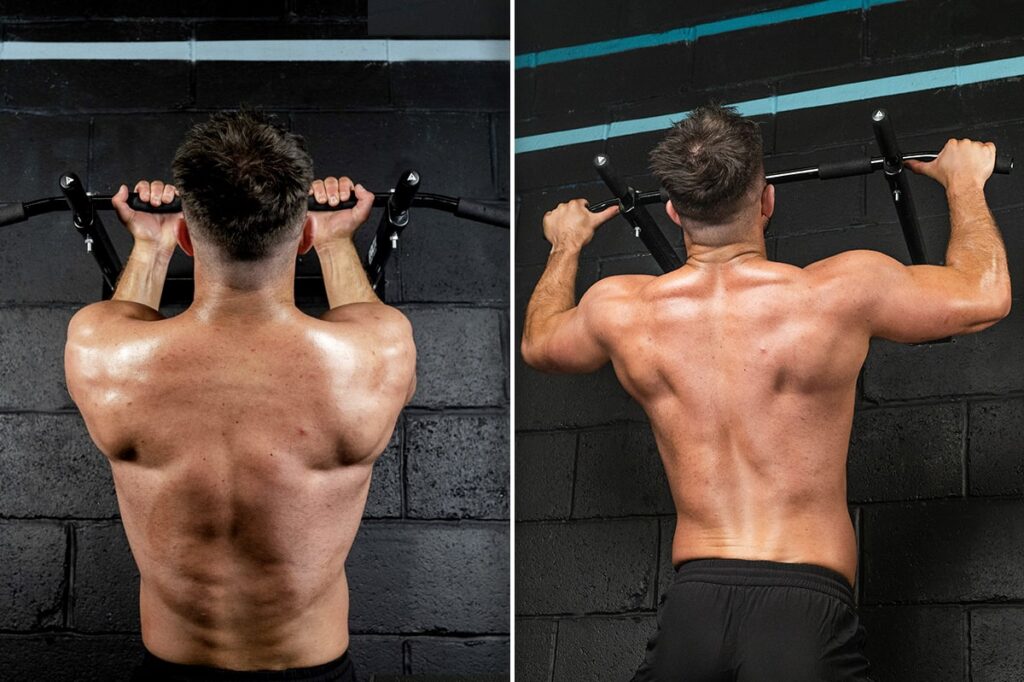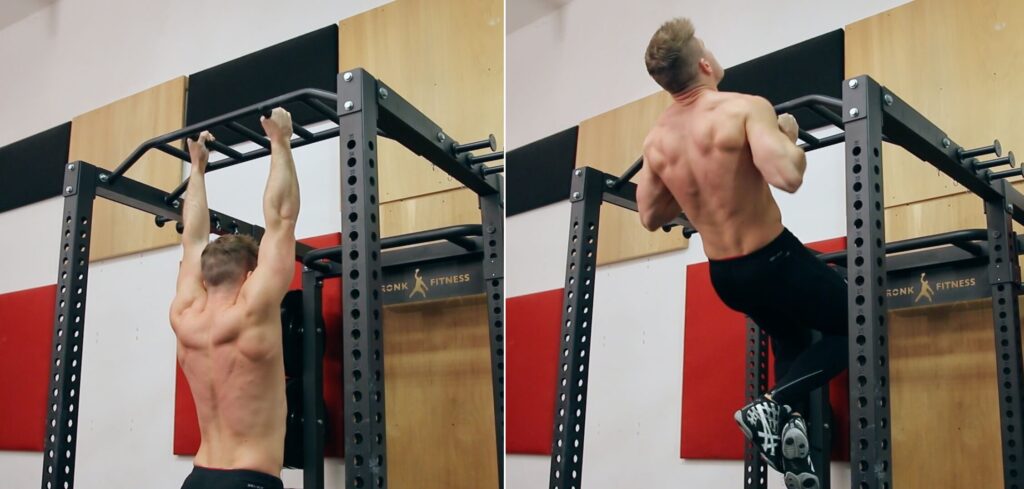Pull-ups are an excellent compound exercise that targets multiple muscle groups in the upper body. While pull-ups are known for their effectiveness in building back strength and developing a V-shaped physique, the proper grip plays a crucial role in maximizing the benefits of this exercise. In this comprehensive guide, we will delve into the importance of choosing the best pull-up grip, explore various grip options, discuss their unique benefits, and provide considerations for selecting the grip that aligns with your specific goals.
Importance of Proper Grip in Pull-Ups:
A proper grip during pull-ups not only ensures stability and safety but also determines the muscle groups that are primarily engaged. By selecting the best grip, you can emphasize certain muscle areas, enhance overall strength gains, and achieve a well-rounded upper body development.
Exploring Different and The Best Pull-Up Grips and Their Benefits
Overhand Grip (Wide and Close)

Description and hand placement for overhand grip:
The overhand grip is a widely used grip technique for pull-ups. It involves placing the palms facing away from the body. With the overhand grip, you have the flexibility to adjust your hand placement to target specific muscle groups. A wider grip, where your hands are positioned wider than shoulder-width apart, primarily engages the back, lats, and biceps. Conversely, a narrower grip, with your hands closer together, emphasizes the inner back muscles.
Muscles worked: emphasis on the back, lats, and biceps
The overhand grip primarily targets the major muscles of the back, including the latissimus dorsi (lats), rhomboids, and trapezius. Additionally, the biceps act as synergistic muscles during the movement, assisting in the pulling action.
Benefits and variations for targeting different muscle groups:
By utilizing the overhand grip, you can develop overall back strength and enhance the width of your back. A wider grip places more emphasis on the lats and outer back muscles, contributing to a broader appearance. On the other hand, a narrower grip places greater emphasis on the inner back muscles, helping to create a more defined and detailed back development. Experimenting with grip width allows you to target specific areas of the back more effectively.
Underhand Grip (Supine or Chin-Up Grip)

Description and hand placement for underhand grip:
The underhand grip, also known as the supine or chin-up grip, involves placing the palms facing towards the body. This grip is achieved by gripping the bar with your palms facing you and hands shoulder-width apart.
Muscles worked: emphasis on biceps, chest, and lower back
The underhand grip primarily targets the biceps, as they are engaged throughout the movement to a greater extent. Additionally, the chest muscles, particularly the pectoralis major, are involved. The lower back muscles, including the erector spinae, are also activated as stabilizers.
Benefits for developing upper body strength and power:
The underhand grip is highly effective for developing upper body strength and power. It places a greater emphasis on the biceps, aiding in their growth and development. Furthermore, the chest muscles are engaged more prominently, contributing to a well-rounded upper-body physique. The involvement of the lower back muscles enhances overall stability and control during the movement.
Mixed Grip (Underhand and Overhand Combination)

Description and hand placement for mixed grip:
The mixed grip involves alternating the hand positions by using an underhand grip with one hand and an overhand grip with the other. This grip is commonly used in powerlifting and can also be applied to pull-ups.
Muscles worked: emphasis on the back, lats, and biceps
The mixed grip primarily targets the back muscles, lats, and biceps, similar to the overhand grip. However, the mixed grip provides enhanced stability and grip strength, making it a preferred choice for individuals with grip limitations.
Benefits and considerations for grip variation and muscle recruitment:
The mixed grip offers a unique advantage by allowing for a more secure grip on the bar, which can increase pulling strength and performance. By using this grip, you can overcome grip weaknesses and challenge your muscles in different ways. However, it’s important to alternate the hand positions to ensure balanced muscle recruitment and avoid muscle imbalances.
Parallel Grip (Neutral Grip)

Description and hand placement for parallel grip:
The parallel grip, also known as the neutral grip, involves using handles or bars where the palms face each other. This grip is achieved by placing the hands on parallel bars with palms facing inward.
Muscles worked: emphasis on biceps, upper back, and shoulders
The parallel grip primarily targets the biceps, upper back muscles (such as the rhomboids and rear deltoids), and the shoulders. This grip offers a joint-friendly alternative to the traditional grips, reducing stress on the wrists and shoulders.
Joint-friendly alternative with reduced stress on the wrists and shoulders:
The parallel grip is especially beneficial for individuals with wrist or shoulder discomfort or those seeking a variation that places less stress on these areas. The neutral hand position reduces the strain on the wrists, making it a suitable option for individuals with wrist injuries or limitations. Additionally, the parallel grip minimizes the risk of shoulder impingement, making it a safer choice for those with shoulder issues.
Learn more: 12 Pull Day Exercises & Workouts
Wide Grip vs. Close Grip: Which is Best?
Comparing the benefits and muscle activation of wide and close grips:
The choice between a wide grip and a close grip depends on individual goals and preferences. Both grip variations offer unique benefits and activate different muscle groups.
Factors to consider based on individual goals and preferences:
When determining the best grip for your pull-up routine, consider your specific goals and preferences. A wide grip emphasizes the outer back muscles and lats, contributing to a broader back appearance. In contrast, a close grip targets the inner back muscles, creating a more defined and detailed back development. Choose the grip that aligns with your desired aesthetic and focus on the muscle groups you want to emphasize.
Determining the Best Grip for Your Back
Assessing muscle imbalances and weaknesses in the back:
To optimize your back development, it’s important to assess any muscle imbalances or weaknesses you may have. Identifying areas that need improvement allows you to tailor your grip selection accordingly.
Tailoring grip selection to target specific areas of the back:
Experimenting with different grips and hand placements enables you to target specific areas of your back. If you notice weaknesses in the upper back, a wider grip may be more effective. Conversely, if the lower back requires more attention, a narrower grip can be beneficial. Continuously assess your back development and adapt your grip selection accordingly.
Experimenting with different grips to find the most effective for your back development:
Finding the best pull-up grip for your back development may require some experimentation. Don’t be afraid to try different grip variations and observe how they impact your muscle activation and overall performance. By listening to your body and adapting your grip selection, you can achieve optimal results.
Considering Individual Factors and Preferences
Understanding that the “best” grip may vary for different individuals:
It’s crucial to acknowledge that the “best” pull-up grip can vary from person to person. Factors such as comfort, grip strength, and injury history play a significant role in determining the ideal grip. What works for one individual may not work for another.
Factors to consider: comfort, grip strength, and injury history:
When selecting your pull-up grip, consider your comfort level with each grip variation. Choose a grip that feels natural and allows you to maintain proper form throughout the exercise. Additionally, assess your grip strength and select a grip that challenges you appropriately without compromising your ability to complete the desired number of repetitions. Take into account any past or current injuries, as certain grips may aggravate specific conditions. Prioritize safety and choose a grip that minimizes the risk of injury or discomfort.
Experimenting with different grips to find what works best for you:
Ultimately, the best pull-up grip for you is the one that aligns with your goals, feels comfortable, and allows you to effectively target the desired muscle groups. Experiment with different grips during your training sessions to determine which grip variation yields the best results for your back development. Keep an open mind and be willing to adjust and adapt your grip as you progress in your fitness journey.
FAQ: Best Pull-Up Grip for Maximum Back Development
Which pull-up grip is best for targeting the lats?
The overhand grip with a wide hand placement is most effective for targeting the lats. This grip engages the back muscles and emphasizes the width of the upper back.
Are mixed grips necessary for building back strength?
Mixed grips, combining underhand and overhand grips, offer advantages such as improved grip strength and stability. While not necessary for everyone, they can be beneficial for individuals with grip limitations or those seeking to challenge their muscles in different ways.
Can the parallel grip be used as an alternative to traditional pull-up grips?
Yes, the parallel grip (neutral grip) is an excellent alternative to traditional grips, especially for individuals with wrist or shoulder discomfort. It targets the biceps, upper back, and shoulders while reducing stress on the wrists and shoulders.
How can I determine the best grip for my back?
Assessing muscle imbalances and weaknesses in your back is key. Experiment with different grips, pay attention to how they feel and the muscle activation they provide. Tailor your grip selection based on the areas you wish to target and the results you want to achieve.
Is there a one-size-fits-all best pull-up grip?
No, the best pull-up grip varies for individuals based on factors like comfort, grip strength, and injury history. It’s important to find a grip that feels natural and allows you to maintain proper form while considering your specific goals and preferences.
Can I switch between different pull-up grips during my training?
Absolutely! Switching between grips can add variety to your routine and challenge your muscles in different ways. Experiment with different grips and observe how they impact your performance and muscle activation.
Should I prioritize grip strength development alongside back strength?
Developing grip strength is beneficial for overall upper body strength and pull-up performance. Incorporate exercises specifically targeting grip strength, such as dead hangs or farmer’s walks, to enhance your grip capabilities.
How important is proper form when performing pull-ups with different grips?
Maintaining correct form is imperative to optimize the benefits of pull-ups and reduce the potential for injuries. Maintain a stable and engaged core, avoid swinging or using momentum, and focus on controlled movements throughout the exercise, regardless of the grip used.
Are pull-up grips suitable for beginners?
Yes, pull-up grips can be adapted for beginners by using assistance bands or modified versions of the exercise. Start with an appropriate level of difficulty and gradually progress as your strength improves.
Remember to consult with a fitness professional or healthcare provider if you have any specific concerns or limitations before incorporating new exercises or grips into your training routine.
Conclusion
Choosing the best pull-up grip is a vital component of maximizing your back development and overall upper body strength. The various grip options, such as the overhand grip (wide and narrow), underhand grip (supine or chin-up grip), mixed grip, and parallel grip, each offer unique benefits and target different muscle groups. Assessing your individual factors and preferences, as well as experimenting with different grips, will help you find the most effective grip for your goals. Remember to prioritize proper form, focus on progression, and individualize your approach to achieve optimal results. By incorporating the best pull-up grip into your training routine, you can unlock the full potential of this dynamic exercise and attain a stronger, more sculpted back.


